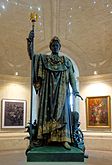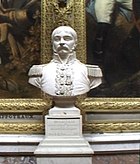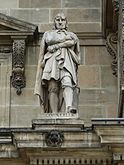
The Hôtel des Invalides, commonly called Les Invalides, is a complex of buildings in the 7th arrondissement of Paris, France, containing museums and monuments, all relating to the military history of France, as well as a hospital and an Old Soldiers' retirement home, the building's original purpose. The buildings house the Musée de l'Armée, the military museum of the Army of France, the Musée des Plans-Reliefs, and the Musée d'Histoire Contemporaine. The complex also includes the former hospital chapel, now national cathedral of the French military, and the adjacent former Royal Chapel known as the Dôme des Invalides, the tallest church building in Paris at a height of 107 meters. The latter has been converted into a shrine of some of France's leading military figures, most notably the tomb of Napoleon.

The Prix de Rome or Grand Prix de Rome was a French scholarship for arts students, initially for painters and sculptors, that was established in 1663 during the reign of Louis XIV of France. Winners were awarded a bursary that allowed them to stay in Rome for three to five years at the expense of the state. The prize was extended to architecture in 1720, music in 1803 and engraving in 1804. The prestigious award was abolished in 1968 by André Malraux, then Minister of Culture, following the May 68 riots that called for cultural change.

James Pradier was a Genevan-born French sculptor best known for his work in the neoclassical style.

The Church of Sainte-Marie-Madeleine, or less formally, La Madeleine, is a Catholic parish church on Place de la Madeleine in the 8th arrondissement of Paris. It was planned by Louis XV as the focal point of the new Rue Royal, leading to the new Place Louis XV, the present Place de la Concorde. It was dedicated in 1764 by Louis XV, but work halted due to the French Revolution. Napoleon Bonaparte had it redesigned in the Neoclassical style to become a monument to the glory of his armies. After his downfall in 1814 construction as a church resumed, but it was not completed until 1842. The building is surrounded on all four sides by columns in the Corinthian style. The interior is noted for its frescoes on the domed ceiling, and monumental sculptures by François Rude, Charles Marochetti and other prominent 19th-century French artists.

Pierre-Jean David was a French sculptor, medalist and active freemason. He adopted the name David d'Angers, following his entry into the studio of the painter Jacques-Louis David in 1809 as a way of both expressing his patrimony and distinguishing himself from the master painter.

The Church of St. Eustache, Paris, is a church in the 1st arrondissement of Paris. The present building was built between 1532 and 1632.

The Basilica of Saint Clotilde is a basilica church located on the Rue Las Cases, in the 7th arrondissement of Paris. It was constructed between 1846 and 1856, and is the first example of a church in Paris in the neo-Gothic style.

Charles-François Lebœuf, called Nanteuil was a French sculptor.
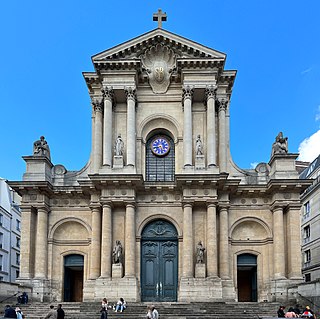
The Church of Saint-Roch is a 17th–18th-century French Baroque and classical style church in Paris, dedicated to Saint Roch. It is located at 284 rue Saint-Honoré, in the 1st arrondissement. The current church was built between 1653 and 1740.

Étienne-Jules Ramey, called Ramey fils, was a French sculptor.

Edme Gaulle was a French sculptor.

Théophile François Marcel Bra was a French Romantic sculptor and exact contemporary of Eugène Delacroix. He was deeply involved in the Romantic era through his uncompromising personality and complex spirituality. His fantastical inspiration evokes the universes inhabited by Goya, William Blake or Victor Hugo - he was at one and the same time a Bonapartist and an anglophile, a passionate Christian disciple of Swedenborg and an admirer of Judaism, Hinduism and Buddhism.

The Church of the Val-de-Grâce is a Roman Catholic church in the 5th arrondissement of Paris. The church was originally proposed as part of a royal abbey by Anne of Austria, the Queen of France, to celebrate the birth of her son, Louis XIV in 1638. It was begun in 1645 by the architect François Mansart, and completed in 1665 by Gabriel Le Duc. The abbey and church were turned into a hospital during the French Revolution. and then became part of the Val-de-Grâce Hospital, which was closed in 1979. The church is attached to the diocese of the French military, and is open to visitors at certain hours. Its dome is a landmark in the skyline of Paris.

Notre-Dame-de-Lorette is a Roman Catholic church located in the 9th arrondissement of Paris, It was built between 1823 and 1836 in the Neo-classical architectural style by architect Louis-Hippolyte Lebas, in a neighbourhood known as the New Athens, for its many artistic and scholarly residents in the 19th century, including George Sand, Pierre-Auguste Renoir, and Alexandre Dumas. While the exterior is classical and austere, the church interior is known for its rich collection of paintings, sculpture, and polychrome decoration.

Jean-François-Théodore Gechter was a French sculptor. A student of François Joseph Bosio and baron Gros, he is now most noted for his bronzes. He first exhibited in 1824, in a show of classical and mythological subjects. From 1830 he shifted to smaller sculptures and animal subjects, like Antoine-Louis Barye, another student of Bosio and Gros. He also had a talent for historical scenes with figures in elaborate costumes.

Édouard Charles Marie Houssin was a French sculptor.
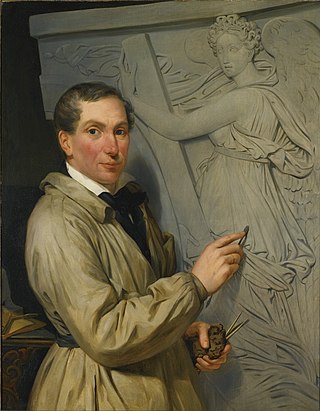
Charles-René Laitié was a French sculptor.

Baron Henri Joseph François de Triqueti, also spelt Henry de Triqueti, was a French sculptor and artist.

Józef Pyrz, known in France as Joseph or Jonasz Pyrz, was a Polish sculptor, poet and philosopher who lived in France from 1979 until his death. Also known as the "Prophet" ("Prorok"), Joseph Pyrz was the co-founder and leader of the hippie movement in Poland in the 1960s and 1970s. He was born on 17 February 1946 in Gawłówek, Poland, and died there on 24 Sept 2016 while on a visit.

Notre-Dame-de-la-Compassion is a Roman Catholic Church located on Place du Général Koenig in the 17th arrondissement in Paris. It was originally built in 1842–43 as a memorial chapel to Ferdinand Philippe, Duke of Orléans, the heir to King Louis-Philippe of France, who was killed in a road accident in 1842. It was built in the Neo-Byzantine style, with elements of Gothic, Baroque and other styles, and was originally called the Chapelle Royale Saint-Ferdinand. In 1970 it was moved stone by stone from its original location a short distance away to make space for the new Palais des Congrès. It became a parish church in 1993. Its notable decoration includes stained glass windows designed by Jean-Auguste-Dominique Ingres, and sculpture by Henri de Triqueti. It was designated a French historic monument in 1929.

